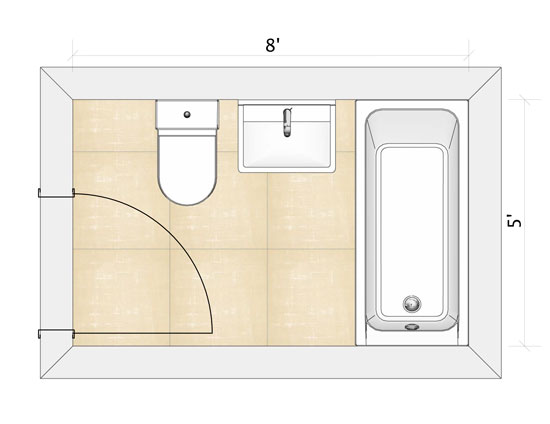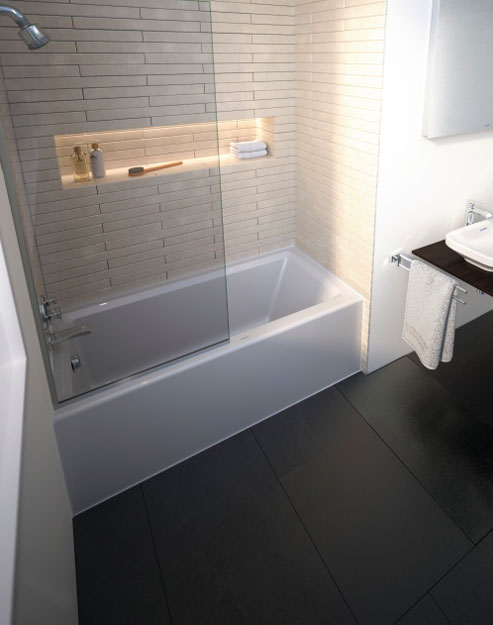Optimizing Small Bathroom Spaces
Small for a Reason
A number of factors are contributing to the need for smaller bathrooms. The underlying values are not new. Elegance over excess, function over frill, emphasis on the essential have been powerful concepts in modern design from “Less is more” before World War II to the current “tiny house” movement. But other contemporary trends are at work, as well. There is widespread recognition of the positive environmental and lifestyle benefits of density. Young cultural creatives and downsizing baby boomers alike are moving to urban areas with more amenities and a less transportation-intensive way of living. Financial uncertainty, lower rates of household formation, a changing housing market and a high demand for rentals are just a few of the factors driving a strong increase in multi-family construction. In multi-family developments—from affordable units all the way across the spectrum to new luxury high-rise developments in big cities—the bathrooms may vary extremely in design, finishes and furniture, but very few are anything but small.
Designing Small
Two basic design approaches to furnishing and equipping a small bathroom that will provide both function and amenity are: (1) space-saving units especially designed to be shaped differently or to have dimensions less than conventional counterparts. Examples include innovative compact folding showers, low-projection wall-hung toilets in various configurations, even ultra-small saunas and whirlpools; and (2) units that combine functions ordinarily requiring two or more separate units, such as basins and toilets with built-in storage, shower and bath combinations, and toilet-bidet units with multiple carefully thought out features concealed in simple ergonomic form. These categories overlap, in the best cases, with combinations that deliver multiple functions but still take up less space than conventional pieces.
Examples of these strategies are discussed below. In some cases, the element itself is spacesaving. In others, the essential bath, shower, toilet, basin, storage and lighting elements have been reconfigured and combined into innovative shapes and sizes. But all the examples are designed to be comfortable, enjoyable to use, and pleasing to the eye as well as functional. International designers such as Philippe Starck, Phoenix Design, EOOS, Norman Foster, Sieger Design and others have been interested in the challenge of redefining bathroom essentials into objects of high style. A broad range of forms, finishes and coordinated product suites are now available, so the bathroom’s design can respond directly to individual taste.
In bathrooms of any size, but particularly in small spaces where corner cutting (both literal and figurative) might be a temptation, certain basic requirements for furnishings and equipment are fundamental, and should be demanded even in products for a small bathroom:
Excellent function: the objective is to increase performance, not sacrifice it to save space. Criteria such as shower-water pressure, temperature adjustment, toilet efficiency, abundant excellent lighting, ample storage and others must be uncompromised.
Health and hygiene first: there must be a strong emphasis throughout on ease of cleaning and resistance to moisture and bacteria, including the use of advanced materials such as special coatings available for ceramics, developed on the basis of nanotechnology; anti-microbial treatment for stainless steel components; and easy removal of parts like toilet seats for complete cleaning.
Comfort and personalization: wherever possible, units should include flexible and programmable temperature, water pressure, and other settings for personalized experience.
Efficient lighting: LED lighting is to be preferred, not only for the quality of natural, truer, brighter light, but also for energy efficiency. LED light is low voltage, easily programmed, emits low radiation and can be easily connected to a wall switch using a standard 120V power source. In a small bathroom, efficient LED lighting may be the only lighting required, especially with the use of mirrors and mirrored cabinets.
Style and aesthetic appeal: Products should be offered in a wide range of design possibilities, including suites with a single coordinated style. Natural materials such as wood finishes give small spaces the feeling of larger furnished rooms. Real-wood veneers can be constructed specifically for bathroom applications, in multiple varieties from oak and walnut to macassar and pearwood. Moisture-resistant high-gloss painted surfaces produce a completely different design effect. Ceramics lend themselves to almost unlimited forms and sizes, sculptural or geometric.
Adaptability to universal design: Whether in applications where legal accessibility standards must be met, or in the increasing number of bathrooms where universal design is a priority for a range of different reasons, bathroom furniture and products must be available in flexible sizes and configurations that can adapt to challenging requirements, as discussed later in this course.
Sustainability: “Small” is in itself a sustainable concept, but even a small bathroom should be designed with conscious attention to efficient water and energy use, and to the sustainability of the way the products are manufactured.
Architect, engineer and international authority on visionary sustainable design Professor Werner Sobek summarizes a modern approach to bathroom design as creating a space “Hygienic and, in the overall balance, economical. But nevertheless joyful.”
Thought Experiment
The next sections will consider innovative design solutions that can be essential “building blocks” for providing maximum function in minimum space. We’ll also consider how to put these elements together to achieve accessibility and sustainability goals, and to achieve those intangible positive benefits people expect from their bathrooms. As you’re reading, you might be thinking about how a complete, stylish bathroom with bathing, handwashing, toilet, storage and lighting might be achieved in a 5 x 8 space like this. Later in the course we’ll show you a few innovative small bathrooms that combine elements we’ve talked about.

Image courtesy Duravit AG
Disappearing Shower

Photo courtesy of Duravit AG
This innovative shower enclosure opens visual and usable space by folding away between uses.
A large shower enclosure can take up almost all the space in a small bathroom, yet it’s only used for short periods. If it could disappear when not in use, additional usable space would appear in its place. In this innovative shower concept, the shower enclosure basically folds away between uses, creating square footage for standing, moving or sitting, and visual open space making the bathroom appear larger. The chrome frame is mounted in a corner, and two large self-locking doors made of 3/8-inch thick safety glass are fitted into the frame, pivoting out when the shower is needed and resting flat against the wall when not. The doors can be lifted and folded into the frame, or opened 90 degrees and locked into the shower position, guaranteeing protection from splashing. They can also be opened 180 degrees, for easy cleaning. The frame is designed especially for stability, with an integrated U-profile that compensates for wall unevenness, a useful feature in older buildings.
The doors can be translucent or mirrored on one side, adding to the visual space and creating a full-length mirror. The frame also conceals the tap fittings, shower attachments and toiletries.
These showers can work with tile floors, or combine with specially designed flush-mounted shower pans to make a tight seal. The seamless acrylic trays create a clean and unified aesthetic, are hygienic and easy to clean, and also compensate for irregularities in the floor. Their open access is particularly useful in universal designs or to meet accessibility standards.
A multitude of standard hand showers may be combined with a special adapter for use in the shower. Fittings can be installed on left or right for versatile placement in tight corners.
Another option designed specifically to make the most of a small space is an innovative compact shower/tub, a modern approach to the standard bath alcove. The unit features a smooth, flat apron front and an integral tile flange on three sides that allows for a continuous flow of the front panel to the floor, a design that has a distinctive contemporary aesthetic, but significant practical value as well, making both initial installation and long term cleaning and maintenance faster and easier. An adjustable leveling foot support system allows for less costly and more efficient installation by providing a stable foundation without the need for additional bedding compound. The panel tub further increases flexibility in tight, challenging spaces by integrating left- or right-hand drains.

Photo courtesy of Duravit AG
This streamlined shower/tub combination makes good use of small space, while significantly reducing installation time and cost.
Taking luxury to yet another level, there are also mini steam showers and saunas available today, although mainly in the European market. One stylish steam shower has a footprint of no more than one square meter. A full-fledged sauna complete with concealed hot stones and a sophisticated control panel offers a comfortable amount of space for one very happy person at 47 ¼ by 47 ¼ inches.









